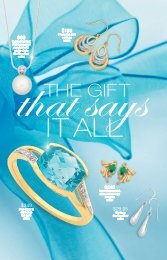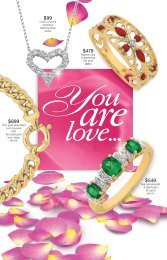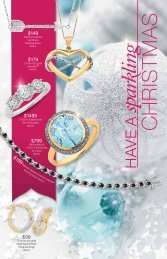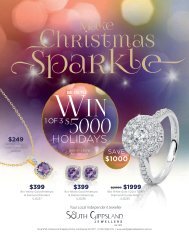Kennedy's Shine Magazine 2015
Kennedy's Shine Magazine 2015
Kennedy's Shine Magazine 2015
Create successful ePaper yourself
Turn your PDF publications into a flip-book with our unique Google optimized e-Paper software.
A beautiful<br />
EDUCATION<br />
There’s more to a stunning diamond<br />
than first meets the eye. Here’s what you<br />
need to know about a girl’s best friend.<br />
“Better a diamond with a flaw than a pebble without,” said Confucius. Indeed,<br />
diamonds by their very nature are a delight to look at, and anything more<br />
than a billion years in the making has got to be pretty remarkable.<br />
But there is much more to diamonds than just sparkle, and no two diamonds<br />
are exactly alike. You might have noticed, for example, that some shine more<br />
brightly, or are more symmetrically cut, or appear clearer.<br />
So what sets apart a ‘good’ diamond from a truly top-tier sparkler? It’s all<br />
about the four Cs – how these elements interrelate determines a diamond’s<br />
overall beauty, rarity and (monetary) value.<br />
Cut<br />
The cut of a diamond refers to its facets and proportions,<br />
not just its shape. The proportions between the table, the<br />
crown, the pavilion and the girdle are extremely important<br />
in ensuring the radiance is maximised. For this reason,<br />
sometimes cutting the diamond smaller to better its<br />
proportions can make it more valuable.<br />
Heavy Deep Cut Ideal Cut Light Shallow Cut<br />
DIAMOND TERMS<br />
Pavilion Crown<br />
Colour<br />
Table<br />
Culet<br />
Girdle<br />
The whiter the colour of the diamond, the greater its<br />
capacity to reflect and refract light, and create a greater<br />
brilliance. The highest quality diamonds are described as<br />
colourless and are extremely rare. This, of course, makes<br />
them very valuable. Jewellers grade a diamond’s colour on a<br />
scale beginning with D (colourless) and moving through to Z.<br />
Clarity<br />
The more pure the clarity, the more brilliant the diamond<br />
appears. Diamonds are graded according to their<br />
combinations of minute mineral traces and crystal<br />
dislocations called inclusions. Flawless diamonds are<br />
extremely rare and valuable because the fewer the<br />
inclusions, the less interference with the passage of light<br />
(hence its greater sparkle).<br />
CLARITY GRADING SCALE<br />
FL IF<br />
VVSI-2 VSI-2 SI 1-2 I1 I2-3<br />
THE EXPERT<br />
When looking at the cut of a diamond, says<br />
gemologist and diamond expert Tony Smallwood,<br />
it’s all about “how the diamond performs”. Once<br />
you’ve checked its specifications on the certificate,<br />
this comes down to visual observation. “Look<br />
at how ‘bright’ the diamond is - or, technically<br />
speaking, how much light is ‘returned’ to the<br />
viewer,” he explains. “Look also at how it ‘sparkles’<br />
as it is moved, which is referred to as ‘scintillation’<br />
- and how the flashes of ‘colour’ come out of a<br />
stone, too - which, technically speaking, is the<br />
diamond’s ‘dispersion’.”<br />
Carat Weight<br />
Carat is a term referring to the weight of a diamond and<br />
not its size in dimensions. The weight of a diamond alone is<br />
not all that is considered as a large stone is not particularly<br />
valuable if it lacks high-grade colour, brilliance or clarity.<br />
The size and shape of the “rough” diamond usually dictates<br />
the “shape” of the final diamond produced.<br />
10 SHINE | ISSUE 1<br />
“The greater<br />
the clarity, the<br />
more brilliant<br />
the diamond<br />
appears.”<br />
GIA<br />
COLOUR<br />
GRADING<br />
SCALE<br />
D E F G H I J K L M N O P Q R S T U V W X Y Z<br />
colourless near colourless faint yellow very light yellow light yellow<br />
Who knew?<br />
The word diamond<br />
comes from the Repair<br />
Greek word ‘adámas’, Service<br />
meaning ‘unbreakable’.<br />
Jewellery<br />
Care<br />
Valuations<br />
Only one polished<br />
diamond out of a<br />
thousand weighs<br />
more than one carat.<br />
Diamonds have<br />
been treasured as<br />
gemstones since their<br />
use as religious icons<br />
in ancient India.<br />
Diamonds are often<br />
brought to the earth’s<br />
surface by deep<br />
volcanic eruptions.<br />
SHINE | ISSUE 1<br />
11





![JIM3930 KISS 2017 - Lookbook AUS - ALICE SPRINGS[8]](https://img.yumpu.com/59476582/1/190x234/jim3930-kiss-2017-lookbook-aus-alice-springs8.jpg?quality=85)












